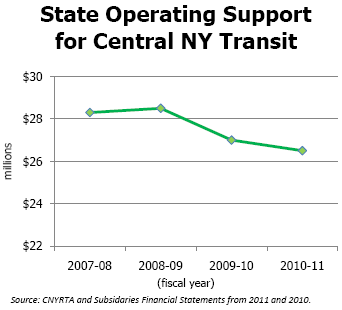In late September, advocates in New York City told state and federal lawmakers, “Don’t X Out Transit” at two events [1]. That message is just as resonant when it comes to the transit systems in upstate New York. Officials at the Buffalo-area Niagara Frontier Transportation Authority have outlined fare hike and service cut proposals [2]. Earlier this year, the Central NY Regional Transportation Authority hiked bus fares in Syracuse by 75 cents [3] (to $2 per ride, a 60% increase).
A big part of the problem is an outdated funding structure that no longer meets the needs of upstate transit riders. Non-MTA transit systems overwhelmingly rely on state aid and local taxes for their operating needs. While the MTA’s budget includes a set of dedicated taxes and fees in the 12-county MTA region, the sole source of dedicated funding for upstate transit systems is a portion of the petroleum business tax (PBT). Tax revenues have stayed relatively flat over the years, while operating expenses have increased over time. Those revenues have covered less and less of what non-MTA transit systems need annually.
As a result, the upstate transit operating account has become increasingly reliant on one-shot transfers from the General Fund, redirected revenues from the downstate transit account, and redirected capital dollars. But relying on one-shot general fund transfers is not sustainable, especially given Albany’s own financial problems. In 2009, Governor Paterson and the State Legislature swept $120 million in dedicated transportation revenues to the general fund. In 2010, the state again deferred $55 million in transit operating aid to 2011 in hopes that the state economy would be on better footing.

In recent years, state funding for the Central NY Regional Transit Authority has declined.
This has led to declining state support for upstate agencies in recent years (see, for example, the Central NY RTA’s figures at right).
Unfortunately, according to projections by the New York Public Transit Association, transit riders upstate and downstate alike will face more fare hikes and service cuts unless Governor Cuomo and the Legislature prioritize transit. Albany officials should keep this in mind when they address transportation funding this fall. Concerns over both the NYSDOT and MTA capital construction programs will have to be addressed by the end of the year; upstate transit needs to be part of the conversation.
By Ya-Ting Liu
Graphics: Top – NYSDOT. Left – Tri-State Transportation Campaign using data from Central New York RTA.
